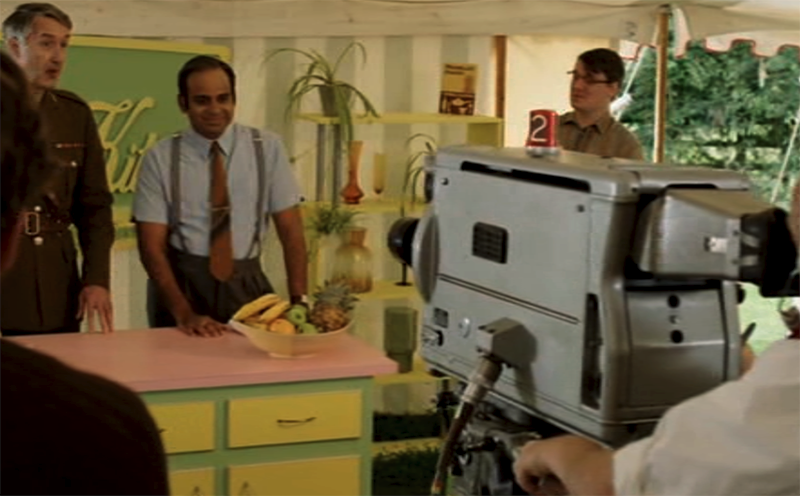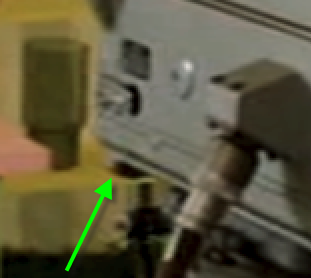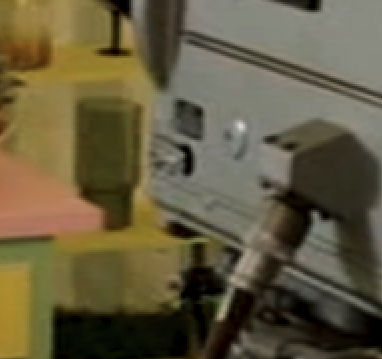Bernie Newnham
The “Sister Boniface Mysteries” is a spin off from “Father Brown”, and has the same sort of English village, murder with a cup of tea vicar, feel.
I fell into this one this afternoon on Drama, because it featured a 1960s tv broadcast. A famous tv cook, a nasty piece of work, was judging a cake contest at the village fete which they were broadcasting. The writer was obviously old enough to have experienced in some way Fanny Craddock, and as someone who once had the joy of her demanding to see the contents of my viewfinder, I watched. The plot is actually very 2022 because the two chaps on the left become a successful gay couple tv cooks at the end.
It was shot on one camera, this one, maybe because Golden Age TV only has one, or they were expensive to hire. The cue light worked ok, but can you spot the large, and very limiting, technical problem?

Graeme Wall
Head still chained?
Nick Ware
The lighting?
Pat Heigham
No talk-back cans plugged in?
No Shot card holder?
Barry Bonner
No TB cans plugged in!
Alec Bray
What an interesting “spot the Error” by Bernie!
Pat said “No talk-back cans plugged in?”, but there ARE cans (OK, maybe not plugged in!!) , just not the STC black ones (or the earlier, real CANS) …
Pat also said that there was no shot card holder – but was this meant to be an OB rather than a studio production – and so would there be a shot card??
Like a lot of you, I first looked at the camera but then spotted something very very strange at the front, It looks a bit like a 4033 mounted vertically, but they were BLACK and I doubt if the black arts of sound would have used a 4033 like that! It looks more like a “Headlight” – as Nick said, a problem with lighting – but these were always mounted on the Top of the camera (in studios at least).

There looks to be a big mounting bar across the front of the panning head and fixed to the camera:

and part of the rig for this looks like the head has still got its chains on.
So my guess is that the big old bar at the front of the camera would prevent it panning down. No problem for the current shot, but if the ped craned up there would be a serious technical problem!

Dudley Darby
The headlights weren’t always mounted on top of the camera in studios. If it was a Mizar they were, but more often than not it was a two-bulb assembly below the camera, and a damned nuisance they were too. We always used to say that their use indicated the lighting man couldn’t light properly! The bulb holders were in aluminium “pudding basin” style reflectors which strangely got knocked about a bit!
Alec Bray
Thank you for the correction!
Pat Heigham
This set-up reminds me of a shoot for British Telecom. A promotional video for a multi-station office phone system. It was necessary for all the right lights to come up as required on camera. Special FX would have wired a unit on push buttons, but BT had to have the system fully connected and working. This meant yards of phone cable everywhere. Come the de-rig, I asked them what was going to happen to all the cable.
In the skip, they replied. I said that the skip was called a Volvo and was outside! They were happy for me to spirit away all the rats’ nest of spaghetti, and I spent some time at home, untangling it, but ended up with a drum of 6 core, practically brand new, most useful telephone cable!
A follow up to the BT phone cable story, which was a good perk.
Purchasing stuff off a production after shooting.
When working on feature films, it’s often possible to buy various pieces when finished with after shooting. The production is always ready to claw back a bit of the outlay cost!
This rather backfired on a couple of the camera boys on ‘Puppet on a Chain’ in Amsterdam.
They put in a bid for the two speedboats, but hadn’t foreseen that they would be virtually wrecked during the canal boat chase!
I had better fortune on a Bond movie. A shop window set in Hong Kong was reproduced in the studio, and dressed with lovely electronic goodies. I asked if I could speak for a Sony cassette deck and a small Sony Trinitron colour TV. The set designer came up to me later and said that he had my stuff in his office if I wanted to complete the deal. Discovered that the boxes were still sealed and had never been opened. I remarked on this and said designer just told me he had added extras to the original purchase list! I came away with my booty, and a pukka receipt, if I was stopped at the studio gate. Although all paid for, it was at a remarkable discount!
(I recall that the BBC had a staff discount scheme running with a business called Giles? Their commercial side did a lot of installation work at TVC, but we could source hi-fi stuff from the retail arm. Think I got a few Quad units that way, I remember they were in Reigate, but could now be Richer Sounds).
Bernie Newnham
I must admit that people have come up with more errors than I had noticed. It’s a little unfair just to show a still, but cumbersome to do more. In the programme the recording camera moves around the prop camera a bit, and the first time I saw it I glimpsed that the chains were on, and looked no further. As the scene went on I was waiting to see it again to see whether I was wrong, but I wasn’t. They did the “recorded” cookery programme, and then the “live” one, and the chains were on all through. Between the two the crew were fiddling a bit with the turret, in a way that said the director had told them to look busy with something.
So a bit like “The Hour” and that Dr Who thing – no sensible consultant, who probably would have done it for expenses just for fun.
Nick’s suggestion of lighting made me think – I wondered if it was just available, but looking again the shot suggests a big soft light off to the left. I used to teach basic lighting at a university, but my problem was having no real modern lighting, which tends to have a lot of big softness about it, often with smaller soft golds low down. What I did was to tell the students about traditional 3 point with much demonstration, and then say that people mostly don’t do that any more because it isn’t natural looking.
I’m all for modern style lighting. Back in the mid seventies I worked on the opera “Falstaff” during the rota cuts. Bob Wright had a full height cyc down the right hand side of the studio which he lit with a quarter of a megawatt. He then made the sun rise, and it was quite incredible. That was the beginning of modern lighting for me. At the uni, we just didn’t have the space or the gear – big translucent stuff or Chinese lanterns or whatever – so old fashioned it was.
Pat Heigham
Bob Wright:
He lit ‘Hamlet at Elsinore’ as an OB, I think. Due to the narrow confines of the real castle, he had the sparks hold redheads(?) on poles, so as to be very mobile. They got christened Boblights.
I too learned 3-point lighting c/o BBC. My story on a commercial runs thus:
One commercial I worked on, shot at Hatchlands, a National Trust property near my home (probably the nearest location I’ve ever had!), was the first Nescafe Gold Blend of the subsequent series. The DoP was none other than the great Freddie Young. He paused by the sound table and enquired who was the boom operator. Me! Asked me my name and said: ”I’m Freddie, and you won’t have any problems”. Standing in the artistes’ position, I took a look – perfectly textbook standard 3-point lighting – key, fill, back.
On another shoot, working on my own, (no boom op) to cover a forum discussion with students on raked seating. Camera centre front.
The ‘inexperienced’ (my reading) cameraman plonked a 2K right behind the camera and then wondered why there was a mike shadow on the back wall, as at the full stretch of the Panamic pole I was going for a chatty bloke at the very back.
Two solutions: move the key light sideways, or do a bit of research as to who might pose decent questions and move them to the front row!
There became a technique of using soft light, bounced off sheets of poly. This built a wall making it physically difficult to get the boom in!
Lighting for colour is better with overall soft, I believe. I suppose three point lighting works in B & W as it’s needed to accentuate the modelling and contrast ratio.
Nick Ware
Lighting: actually I wasn’t referring to camera ‘headlamps’ but the dreary look the set has in your grabbed frame. I think the Marconi Mk IV would expect and need better than that! That’s something that I was acutely aware of at the time because when I joined TechOps in 1960 I had just completed a two year photography course at what was Guildford Art School (*). We had been taught lighting for still photography by amongst others, David Bailey and Tony Armstrong Jones! However, everything they taught me was shattered in fragments when I went on the junior TechOps course, and on the very first page of our lighting handout was a paragraph that listed the basic requirements of lighting for television. No 1 on the list read: “To satisfy the technical requirements of the TV system”. True, of course, but not quite what I had hoped!
(*) For by BBC interview I took along my ARPS photo portfolio, which they looked through and then offered me a job as a sound trainee!
Bernie Newnham
No, not headlamps – I think that was Alec. The scene is sort of dingy, but I think it was intentional – they were in a tent. It just looked as if maybe they’d added some soft off to the left.
h1>



